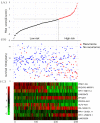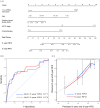A Potential Prognostic Long Noncoding RNA Signature to Predict Recurrence among ER-positive Breast Cancer Patients Treated with Tamoxifen
- PMID: 29453409
- PMCID: PMC5816619
- DOI: 10.1038/s41598-018-21581-w
A Potential Prognostic Long Noncoding RNA Signature to Predict Recurrence among ER-positive Breast Cancer Patients Treated with Tamoxifen
Abstract
Limited predictable long noncoding RNA (lncRNA) signature was reported in tamoxifen resistance among estrogen receptor (ER)-positive breast cancer (BC) patients. The aim of this study was to identify and assess prognostic lncRNA signature to predict recurrence among ER-positive BC patients treated with tamoxifen. Cohorts from Gene Expression Omnibus (GEO) (n = 298) and The Cancer Genome Atlas (TCGA) (n = 160) were defined as training and validation cohort, respectively. BC relapse associated lnRNAs was identify within training cohort, and the predictable value of recurrence was assessed in both cohorts. A total of 11lncRNAs were recognized to be associated with relapse free survival (RFS) of ER-positive BC patients receiving tamoxifen, who were divided into low-risk and high-risk group on basis of relapse risk scores (RRS). Multivariate cox regression analyses revealed that the RRS is an independent prognostic biomarker in the prediction of ER-positive BC patients' survival. GSEA indicated that high-risk group was associated with several signaling pathways in processing of BC recurrence and metastasis such as PI3K-Akt and Wnt signaling. Our 11-lncRNA based classifier is a reliable prognostic and predictive tool for disease relapse in BC patients receiving tamoxifen.
Conflict of interest statement
The authors declare no competing interests.
Figures





Similar articles
-
A prognostic eight-lncRNA expression signature in predicting recurrence of ER-positive breast cancer receiving endocrine therapy.J Cell Physiol. 2020 May;235(5):4746-4755. doi: 10.1002/jcp.29352. Epub 2019 Oct 29. J Cell Physiol. 2020. PMID: 31663114
-
An estrogen receptor (ER)-related signature in predicting prognosis of ER-positive breast cancer following endocrine treatment.J Cell Mol Med. 2019 Aug;23(8):4980-4990. doi: 10.1111/jcmm.14338. Epub 2019 May 23. J Cell Mol Med. 2019. PMID: 31124293 Free PMC article.
-
Estrogen receptor 1 and progesterone receptor are distinct biomarkers and prognostic factors in estrogen receptor-positive breast cancer: Evidence from a bioinformatic analysis.Biomed Pharmacother. 2020 Jan;121:109647. doi: 10.1016/j.biopha.2019.109647. Epub 2019 Nov 13. Biomed Pharmacother. 2020. PMID: 31733575
-
Exploring the clinical potential of circulating LncRNAs in breast cancer: insights into primary signaling pathways and therapeutic interventions.Funct Integr Genomics. 2024 Nov 7;24(6):209. doi: 10.1007/s10142-024-01476-y. Funct Integr Genomics. 2024. PMID: 39508907 Review.
-
The Significance of Thyroid Hormone Receptors in Breast Cancer: A Hypothesis-Generating Narrative Review.Curr Oncol. 2024 Apr 23;31(5):2364-2375. doi: 10.3390/curroncol31050176. Curr Oncol. 2024. PMID: 38785457 Free PMC article. Review.
Cited by
-
7-lncRNA Assessment Model for Monitoring and Prognosis of Breast Cancer Patients: Based on Cox Regression and Co-expression Analysis.Front Oncol. 2019 Dec 3;9:1348. doi: 10.3389/fonc.2019.01348. eCollection 2019. Front Oncol. 2019. PMID: 31850229 Free PMC article.
-
Long non-coding RNAs as monitoring tools and therapeutic targets in breast cancer.Cell Oncol (Dordr). 2019 Feb;42(1):1-12. doi: 10.1007/s13402-018-0412-6. Epub 2018 Oct 25. Cell Oncol (Dordr). 2019. PMID: 30361825 Review.
-
Connecting the Missing Dots: ncRNAs as Critical Regulators of Therapeutic Susceptibility in Breast Cancer.Cancers (Basel). 2020 Sep 21;12(9):2698. doi: 10.3390/cancers12092698. Cancers (Basel). 2020. PMID: 32967267 Free PMC article. Review.
-
Long Noncoding RNAs Involved in the Endocrine Therapy Resistance of Breast Cancer.Cancers (Basel). 2020 May 31;12(6):1424. doi: 10.3390/cancers12061424. Cancers (Basel). 2020. PMID: 32486413 Free PMC article. Review.
-
Long Non-Coding RNAs, Cell Cycle, and Human Breast Cancer.Hum Gene Ther. 2023 Jun;34(11-12):481-494. doi: 10.1089/hum.2023.074. Hum Gene Ther. 2023. PMID: 37243445 Free PMC article. Review.
References
-
- Torre LA, et al. Global cancer statistics, 2012. CA: a cancer journal for clinicians. 2015;65:87–108. - PubMed
-
- Siegel RL, Miller KD, Jemal A. Cancer Statistics, 2017. CA: a cancer journal for clinicians. 2017;67:7–30. - PubMed
-
- Tao Z, et al. Breast Cancer: Epidemiology and Etiology. Cell biochemistry and biophysics. 2014 - PubMed
Publication types
MeSH terms
Substances
LinkOut - more resources
Full Text Sources
Other Literature Sources
Medical

